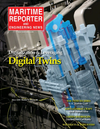
Page 22: of Maritime Reporter Magazine (June 2024)
Read this page in Pdf, Flash or Html5 edition of June 2024 Maritime Reporter Magazine
DIGITALIZATION reau Veritas (BV) to support digital transformation in maritime. optimize ? eet positioning based on the evolution of cargo “The zero-carbon world is here to stay. Rather than ? ght ? ows. Furthermore, local meteorological data on weather, that reality, industry players need to learn how to master it,” wind, currents and waves can be combined with real-time
Riaz says. “An important element of a transformation strategy views of port traf? c, congestion and terminal activities to op- is management of the economic, technological and operational timize routes, fuel consumption and port turnaround time, as risk factors with innovation. This entails balancing the initial well as manage delays and just-in-time arrivals.
digital investment against potential savings in areas such as fuel Operational cost savings can be realized by using digital consumption, ensuring the digital solution is ? t for purpose and tools that can collect and analyze data to identify trends, opti- assessing the impact of implementation on ship operations. mize crewing spend and overall procurement of spares, stores “Consequently, sound technology adoption requires a thor- and provisions, while also streamlining repair, maintenance, ough decision-making procedure underpinned by knowledge port, drydocking and bunkering costs.
of the process to be automated, an understanding of end-user McKinsey cites an example of how a shipping operator was needs, the compatibility and capability of the solution, and able to optimize fuel consumption through a digital interface proper vendor evaluation as best practice.” between the vessel and shore of? ce that provided visibility
Riaz states that shipping can learn lessons from other in- on fuel and emissions data, and transparency on voyage de- dustries such as ? nancial, software and life sciences where cisions. This gave clarity on key levers such as speed, slip, risk-savvy players that acted early in response to regulation to trim and fuel type, and allowed AIS and weather data to be sharpen ef? ciency and better manage information ? ows have leveraged for route mapping and fuel usage, resulting in a 1% emerged as the commercial winners. decrease in fuel spending while also promoting healthy com- “What these industries have in common is that in order to petition among captains to improve voyage performance.
undergo transformation they had to grapple with the issue of The ? rm estimates that companies pursuing digital trans- transparency in terms of data-sharing and protection. Like formation have seen signi? cant EBITDA gains of 15-20% on shipping, they also faced pressure from governments, regula- a run-rate basis, while also “future-proo? ng their businesses, tors, ? nancial institutions and the public,” he says. solidifying their decarbonization plans and building in resil- iency, resulting in higher shareholder value”.
Data Analytics
Research ? rm McKinsey & Company has highlighted how ‘Fast to deploy and future-proof’ application of data and analytics can be leveraged in shipping However, as Riaz points out: “It is important to understand to gain competitive advantage and unlock value, stating that that transformation and transparency cannot happen at scale digital technologies can “help companies navigate these chop- unless technology is fast to deploy, easy to use and designed to py waters” ahead of the next downcycle by enabling prompt be future-proof.” And he believes effective technology adop- decision-making, operational and cost ef? ciencies, and im- tion requires a cultural shift away from siloed data systems, proved performance. “Smart companies are using their cash which slow down business processes and hinder ef? cient de- to invest now in transformation, making them resilient for the cision-making, to data-sharing between different systems and next cycle. Much of this transformation requires an upgrade in company departments. This can generate what OrbitMI calls digital capabilities. Done right, this can enable the emergence intelligent connected work? ows, which are used in its Orbit of modern, data-driven companies with excellent intelligence vessel performance platform to create more value from data to support their commercial and cost decisions,” the ? rm across pre-? xture, voyage and post-? xture processes.
states. According to McKinsey, data and analytics are a key “Point solutions may deliver some bene? ts for speci? c enabler for a transformation framework comprising the three tasks but standalone software operating within a data silo is, main value-creation pillars for shipping companies - strategy, ultimately, counterproductive to the data-driven culture we commercial excellence and vessel-cost optimization. need to achieve real transformation,” Riaz says.
In terms of strategy, shipping companies can draw on data “The focus should be on adopting technologies with collab- and analytics to improve decision-making around ? eet com- oration, integration and data-sharing at their core, so that they position, such as by combining forecasts for cargo demand are both integrable with existing IT infrastructure and scal- and vessel capacity to predict supply-demand imbalances for able for future needs. This can create uni? ed solutions with a speci? c vessel segments. single source of truth for better decision-making, rather than having divergent data from segregated systems.”
Optimized Decision-Making
On the commercial side, revenue can be boosted through ‘Getting data ? owing’ data-informed decisions around ? eet deployment, pool part- His view is supported by research ? rm Thetius’ recent nering and time chartering in and out, making it possible to study entitled ‘Common Interest’, published together with 22 Maritime Reporter & Engineering News • June 2024
MR #6 (18-33).indd 22 6/3/2024 12:05:06 PM

 21
21

 23
23
